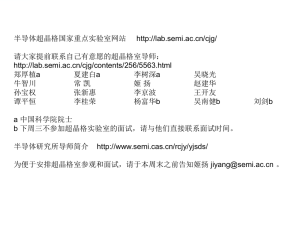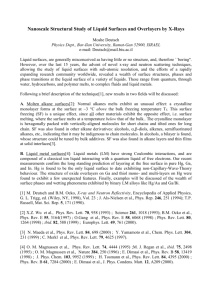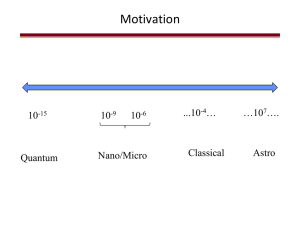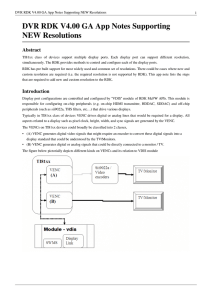Theory of localization and interaction
advertisement
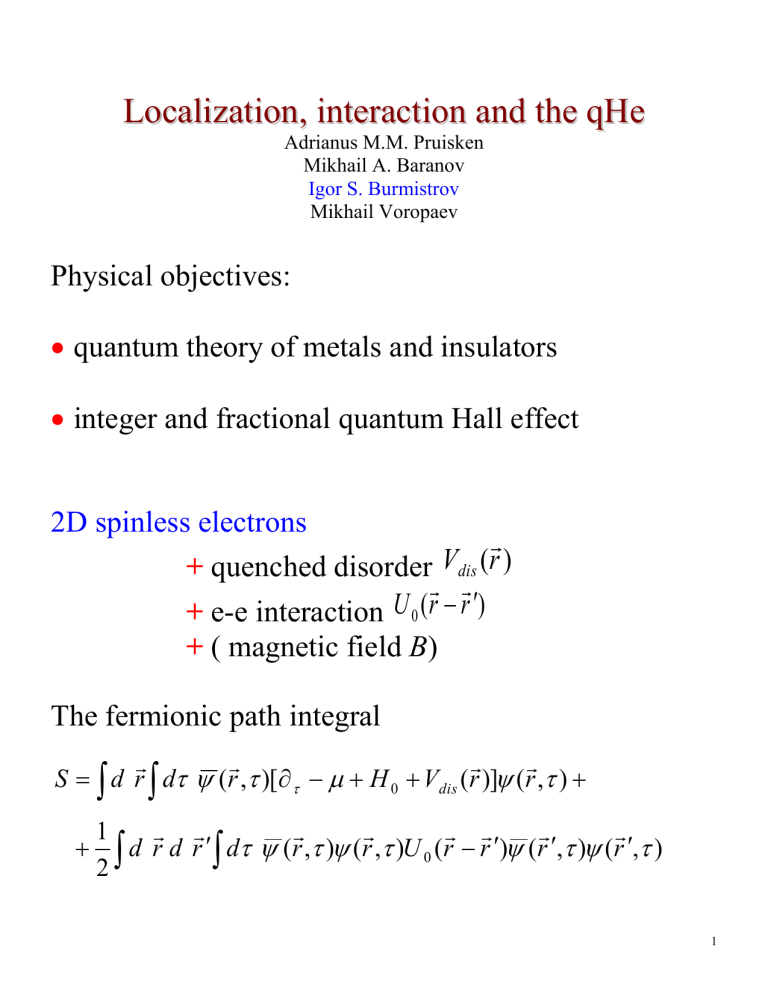
Localization, interaction and the qHe Adrianus M.M. Pruisken Mikhail A. Baranov Igor S. Burmistrov Mikhail Voropaev Physical objectives: quantum theory of metals and insulators integer and fractional quantum Hall effect 2D spinless electrons + quenched disorder Vdis (r ) + e-e interaction U 0 (r r ) + ( magnetic field B) The fermionic path integral S d r d (r , )[ H 0 Vdis (r )] (r , ) 1 , ) d r d r d ( r , ) ( r , ) U ( r r ) ( r , ) ( r 0 2 1 The effective action: Matsubara frequency space n T (2n 1) 1 1 Electronic scattering processes el n el Replica trick N r 0 Q field method ( r , ) ( r , ) (r , n ) (r , m ) Qnm (r ) replica indices space variable r Matsubara frequency indices Nonlinear constraint nm Q 2 (r ) 1 2 The effective action Seff [Q, A ] S [Q, A] S F [Q] SU [Q, A ] free electron part 2 xy xx S [Q, A] tr [ D, Q] ab tr Q [ Da , Q] [ Db , Q] 8 8 singlet interaction term S F [Q] z T tr I n Q tr I nQ 4tr ,n Q the (Coulomb) term i nB 2 1 SU [Q, A ] T tr I n Q(r ) A0 (r , n ) 2 B(r , n ) 2 T T ,n U r -r tr I n i nB 1 Q(r ) A0 (r ,- n ) 2 B(r ,- n ) T T A.M. Finkelstein, JETP Lett. 37, 517 (1983), Sov. Phys. JETP 59, 212 (1984) A.M.M. Pruisken, M.A. Baranov, and B. Škorić, Phys. Rev. B 60, 16807 (1999) 3 The physical parameters of the effective theory: xx , xy mean field conductances z singlet interaction amplitude T temperature U (q) 1 U 0 (q ) … bare interaction U 0 (q) n n nB B thermodynamic DoS … 4 Cutoff N m in frequency space Q T 1 T I n mk k m,n mk m mk mk sign m k ,m F algebra 5 U(1) gauge invariance covariant derivative D i A (r , n ) I n ,n gauge transformations A A Q W 1Q W where W exp i ( n ) I ,n n 6 Overview 1.Perturbative RG one loop A.M. Finkelstein, JETP Lett. 37, 517 (1983), Sov. Phys. JETP 59, 2121 (1984) two loop M.A. Baranov, A.M.M. Pruisken, and B. Škorić, Phys. Rev B 60, 16821 (1999) M.A. Baranov, I.S. Burmistrov, and A.M.M. Pruisken, Phys. Rev B 66, 075317 (2002) 2.Nonperturbative RG functions (instanton gas) A.M.M. Pruisken and M.A. Baranov, Europhys. Lett. 31, 543 (1995) 3.Complete microscopic theory of Luttinger liquid of quantum Hall edge A.M.M. Pruisken, M.A. Baranov, and B. Škorić, Phys. Rev B 60, 16838 (1999) B. Škorić and A.M.M. Pruisken, Nucl. Phys. B 559, 637 (1999) 4.Linear response and continuity equation at quantum level A.M.M. Pruisken, M.A. Baranov, and I.S. Burmistrov, to be published 5.Crossover RG functions (singlet and triplet cases) A.M.M. Pruisken, M.A. Baranov, and I.S. Burmistrov, to be published 7 F algebra N m finite N m infinite finite size Q infinite size Q free electrons interacting electrons one particle problem many-body problem ordinary -model Finkelstein theory Very different physics… How can it be undestood? The effective action ( g 1 / xx ) 1 2 Seff [Q] tr [ Q ] z T c tr I Q tr I n nQ 4tr 8 g ,n c0 free electrons: short ranged e-e interaction: the Coulomb interaction: Q 0 c 1 c 1 8 Background field methodology [analogous to A.M. Polyakov, Phys. Lett. B 59, 79 (1975) for vector model] Q t 1Q t , Q are “fast” modes “large” matrices t SU (2 nm N r ) t are “slow” modes “small” matrices By integrating over Q we obtain the action in terms of q t 1 t the local quantity exp Seff [q] DQ exp Seff [t 1Q t ] 9 bare theory background field action Seff [Q ] g g ( L0 ) g g (L ) c c( L0 ) c c(L) z z ( L0 ) z z (L) S eff [q] RG functions dg ( g , c) d ln L dc c ( g , c) d ln L d ln z z ( g , c) d ln L 10 Crossover RG functions (in 2+ dimensions, T=0) dg 1 c g 2 g 2 f ln( 1 cf ) d ln L c dc gc(1 cf ) d ln L d ln z gcf d ln L where NOTE: f L2 L L 2 N m is finite f 0: short distances: 2 m Lm2 8 2 zTg N m and f=0 at T 0 Free particle theory ( N m finite) L Lm dg g O( g 3 ) d ln L dc gc d ln L d ln z 0 d ln L 11 f 1: Many-body theory ( N m infinite ) L Lm Long distances: dg 1 c g 2 g 2 1 ln( 1 c) d ln L c dc gc(1 c) d ln L d ln z gc d ln L Free particles Short-ranged Long-ranged(Coulomb) interaction interaction N m finite N m infinite N m infinite f=0 f=1 f=1 c<1 c=1 No F invariance F invariance Fermi liquid theory * Non-Fermi liquid theory No F invariance * NOTE: also for f<1 12 Conclusions Frequency cutoff N m = crossover between free electron approximation and many body theory RG, F invariance, F algebra are fundamental tools to understand this crossover General knowledge of theory at finite N m (renormalizability, background field methodology) can be extended to include problem of interacting electrons Finkelstein theory is fundamental theory of localization and interaction effects 13

